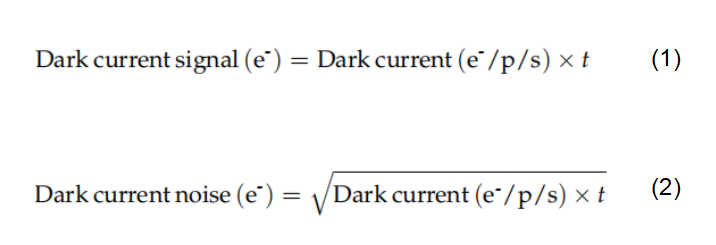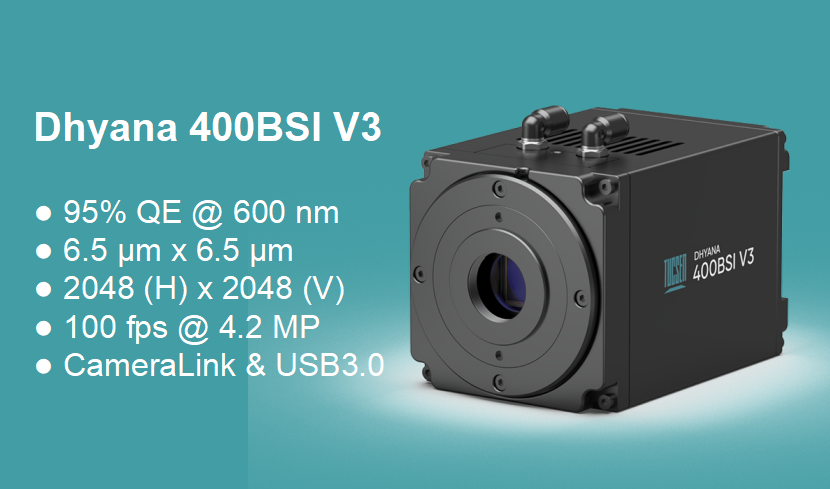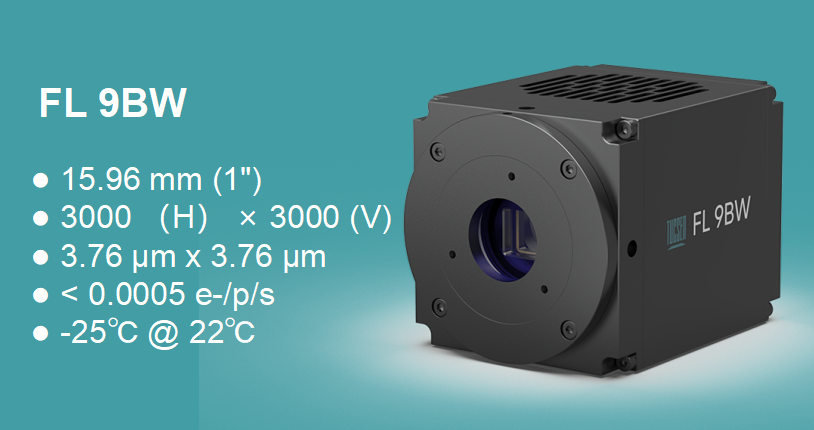Dark current noise is a temperature-dependent and exposure-time-dependent camera noise source. Aiming to reduce dark current is the primary reason why many scientific cameras are cooled. While dark current noise can be negligible at short exposure times, it can be the primary barrier to successful long exposure time imaging, where single frame exposures may be measured in tens of seconds, or up to minutes or hours.
Understanding dark current, its causes, how to calculate it, and ways to reduce its impact is essential for photographers, astronomers, and researchers using scientific cameras. This article provides a comprehensive guide to dark current and practical strategies for managing it effectively.
What Is Dark Current?
Dark current is the small electric current generated by a camera sensor even in complete darkness. It arises from thermal activity within the sensor’s semiconductor material, producing electrons that mimic real photo-generated signals.
It’s important to differentiate between dark current signal and dark current noise:
● Dark current signal: The steady accumulation of electrons over time.
● Dark current noise: The random fluctuations in that signal, which appear as grain or speckles in your image.
Understanding this distinction helps in both calculating and mitigating its effects.
Why Dark Current Noise Happens
Within the sensor of every camera, molecules, atoms, and sub-atomic particles are in constant thermal motion. The greater the temperature of the sensor, the greater the energy of that thermal motion. Within each pixel, electrons will be moving around, driven by this thermal energy.
There is a high likelihood that some of them will make their way into the pixel well – just like our detected photoelectrons from the incoming signal. There is no way to distinguish these thermal electrons from the ‘true’ signal. This is the origin of dark current and dark current noise.
Several factors influence the intensity of dark current:
● Temperature: Higher temperatures increase thermal activity, raising dark current levels.
● Exposure time: Longer exposures allow more dark current to accumulate.
● Sensor type and quality: CCD sensors often have higher dark current than modern CMOS sensors, though this varies by design and manufacturing process.
Dark Current, Dark Current Signal And Dark Current Noise
Over the exposure time, the thermally-generated electrons accumulate in the pixel wells. The total number in a pixel is called the dark current signal (sometimes called just “dark signal”). This is the new ‘baseline’ from which true photon signal must be measured.
Depending on the sensor architecture, design, and temperature, electrons may accumulate at a rate of hundreds per second, or it may take an hour before the entry of a single thermally-generated electron becomes likely.
The typical, average behavior of a given camera sensor is for dark current signal to grow at a set linear rate for a given maintained sensor temperature, measured in electrons per pixel, per second. This average dark current signal rate is commonly referred to on camera specification sheets as the ‘Dark Current’. The dark current signal in a given pixel is given by multiplying this dark current value by exposure time.
Although typically accumulation of dark current signal is linear, it is not necessarily evenly distributed across the sensor. It is very common for cameras to exhibit ‘glows’ at the edges of the sensor, and other nonuniformities. While sometimes different in origin to conventional thermal noise, the high dark signal in these regions can be treated as if their dark current is higher.
The most important factor in our imaging, however, is not necessarily the dark current signal, which due to its linear behavior, can often be subtracted from the resulting images as noted in the section opposite. What cannot be subtracted is the noise contribution due to the random nature of the actual dark electron capture events.
Just as in photon shot noise, although dark current signal accumulates at a known mean rate, the actual individual events are random in time. Therefore, dark current noise obeys Poisson statistics just like photon shot noise. Note, however, that some sources of dark current signal may not obey Poisson statistics, so careful measurement of dark current noise is wise if these values are important to your application.
How to Calculate Dark Current Noise
The noise contribution of dark current, just like other Poisson-statistics noise sources, is the square root of the detected dark current signal.

Where t is the exposure time in seconds. As noted in the equation above, an estimation of the dark current noise in a pixel can be gained from simply taking the square root of the specification sheet dark current value, multiplied by the exposure time. A more accurate measure can be gained by mapping the dark current values of each pixel of the camera.
Subtracting Dark Current from Images
As noted above, dark current will raise the ‘zero signal’ value of pixels. For quantitative techniques requiring measurement or comparison of pixel values, this is not acceptable. Further, if (as is common) the distribution of dark current across the sensor is not even, the resulting pattern may worsen image quality if it is visible on top of the true signal. It is possible to subtract the effect of the accumulated dark current signal from images, leaving only the noise contribution.
How to subtract dark current signal
As noted above, dark current will raise the ‘zero signal’ value of pixels. For quantitative techniques requiring measurement or comparison of pixel values, this is not acceptable. Further, if (as is common) the distribution of dark current across the sensor is not even, the resulting pattern may worsen image quality if it is visible on top of the true signal. It is possible to subtract the effect of the accumulated dark current signal from images, leaving only the noise contribution.
There are two methods depending upon how evenly or unevenly dark current is distributed. In both cases, however, we must take care to either convert our image to units of photoelectrons, or to convert our dark current signal values to gray levels before subtraction.
If dark current accumulation is roughly even across the sensor, then simply subtracting the average dark current signal in gray levels from every pixel may be sufficient:

If, however, dark current is not evenly distributed, it may be necessary to create a dark current map, formed of an average of multiple long exposure dark images. The values in this image can then be scaled according to the exposure time (taking care to account the camera offset) and subtracted from the image. Now, only the noise contribution remains.
Note: Experimental workflows can sometimes include subtracting a single ‘dark frame’ from results, captured just before the experiment begins. For maximizing image quality and SNR, this is not recommended. This will subtract the dark signal and camera offset. But it will add the contribution of the dark frame’s dark current noise and read noise, effectively doubling the contribution of these noise sources.
Cooling vs. Dark Current
It is important to note that although for a given camera sensor, the dark current depends upon the sensor temperature, comparing between different cameras cannot be done based on temperature alone. The sensor architecture and design is a far, far more important factor in determining the extent of dark current than the sensor temperature.
For example, to compare two back-illuminated CMOS cameras:
At a sensor temperature of -25°C, the Tucsen Dhyana 400BSI V3 sCMOS camera exhibits a dark current of 0.2e-/p/s. This means on average 5 seconds of exposure can elapse per electron of dark current signal in each pixel.

At the exact same sensor temperature however, the Tucsen FL 9BW Long Exposure Cooled CMOS Camera, specifically designed for long exposures, exhibits less than 0.0005 e-/p/s, meaning an average exposure time of over half an hour would be required to generate a single dark electron per pixel.

How camera cooling works
The most common form of sensor cooling for scientific cameras is thermoelectric cooling. This typically operates in three ‘stages’:
First, heat is removed from the sensor via a thermoelectric cooler, also called a Peltier cooler, or Peltier plate. This device utilizes the Peltier effect, whereby an electrical component known as a thermocouple will move heat from one side of itself to another, upon application of a voltage.
Secondly, the heat is transferred from the Peltier plates by thermally connected metal components to heat exchangers.
Thirdly, either a fan moves air past the heat exchangers to remove heat to outside of the camera, or a pump moves liquid coolant past them, or they are cooled by passive airflow.
When Is Dark Current Noise Important?
The relative importance of dark current noise depends strongly upon two factors: firstly, the typical exposure times in your experiment or imaging application, and secondly the dark current of your specific camera.
In applications where exposure times are very short, for example, less than 50ms, even uncooled cameras can often have low enough dark current that this can be completely neglected.
However, for longer exposure times, the calculation must be made to check the contribution of dark current. For many high-sensitivity CMOS cameras, an exposure time of just one or two seconds might lead to dark current noise outstripping read noise.
Example: Considerations for Long Exposure Time Imaging
Long-exposure time imaging is defined as applications requiring exposure times of tens of seconds to minutes or hours, to capture imaging subjects with very low photon flux. Application examples include bioluminescence, chemiluminescence and astronomy.
In these applications, dark current must become a specification of primary importance. Additional considerations must also be made however:
● Sensor quality and image corrections can reduce the impact of hot pixels.
● High camera dynamic range can become extremely beneficial as very bright signals can be (intentionally or accidentally) acquired at long exposures, in the same image as dim signals.
● ‘Anti-blooming’ technology and techniques can help avoid saturated pixels leaking signal into their neighbors.
● In some circumstances, it may be useful to increase oversampling using smaller pixels to lessen the impact of cosmic rays or hot pixels on the image, though this may reduce full well capacity.
Conclusion
Dark current is an unavoidable phenomenon in camera sensors, but understanding its causes and impact allows for effective mitigation. By calculating dark current noise, using dark frame subtraction, and employing camera cooling when necessary, you can significantly improve image quality.
For scientific imaging applications, especially those requiring long exposures or high sensitivity, managing dark current is critical. Selecting the right camera, applying proper cooling, and incorporating image processing techniques ensure that your data remains accurate and your images retain maximum detail.
Tucsen specializes in developing advanced scientific cameras designed to minimize dark current and deliver superior performance in demanding imaging environments. Contact us and discover how our innovations can elevate your imaging results.
Tucsen Photonics Co., Ltd. All rights reserved. When citing, please acknowledge the source: www.tucsen.com


 2025/10/21
2025/10/21







